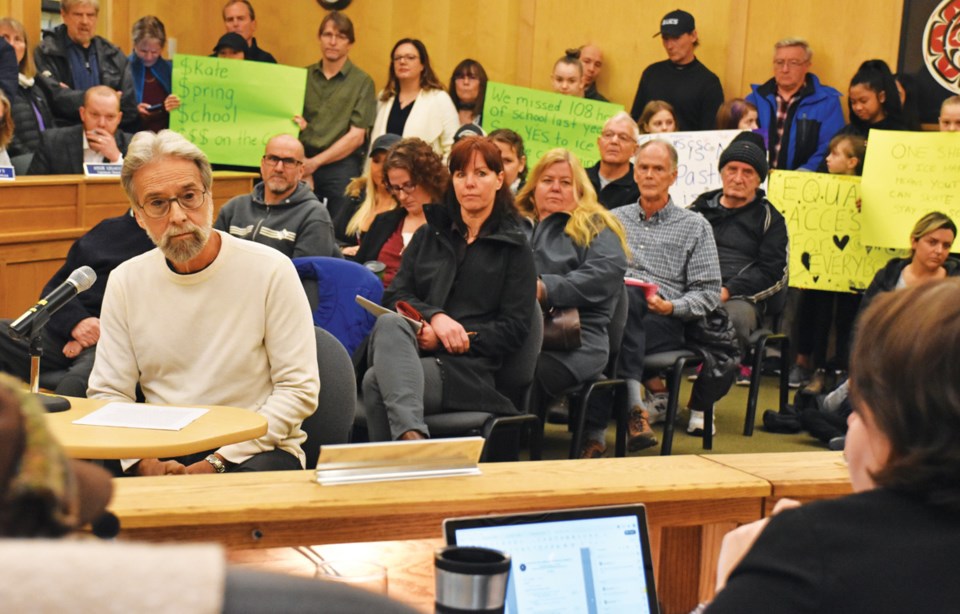A “stop-gap” decision means athletes will have to wait a couple more weeks to find out how ice and dry floor time will be divvied up at the two arenas operated by Sunshine Coast Regional District (SCRD).
Area F director Mark Hiltz characterized the decision that way following an hour and a half of delegations, informal appeals, a recusal and director deliberations at what Sechelt director Darnelda Siegers called an “unorthodox” corporate and administrative services committee meeting.
The final motion – to guarantee ice in one arena until April 30 with the rest of the ice allocation time determined at a committee later in February – would get the directors “three weeks down the road,” said Hiltz following the Jan. 31 vote.
The meeting proceeded against a backdrop of colourful posters held by youth skaters with slogans such as, “Say yes to ice” and “One sheet of ice March – June means youth can skate and stay in school.”
Pickleballers, roller derby athletes and lacrosse players filled out the boardroom and others spilled into the main entrance of the local government headquarters.
The meeting was the latest in a protracted disagreement between skating groups pleading for extended ice time and dry floor users seeking to protect the time they have.
User groups either rent ice from the SCRD or participate in programs offered by the regional district. The SCRD’s Parks and Recreation Master Plan and two allocation policies guide decisions around programming and ice allocation.
Thursday’s staff report admitted “points of conflict and ambiguity” between these policies. It also underlined the difficult role directors play in adjudicating disputes between these groups.
The latest illustration of that ambiguity began last November, when Andrea Watson, president of the Sunshine Coast Skating Association, requested that SCRD extend ice time at one of the arenas, claiming the SCRD is contravening its own ice allocation policy since youth sports weren’t being prioritized. She also argued athletes were left with a choice between missing school days to train off-Coast or being in non-compliance with training guidelines.
That argument prompted directors to request a cost-benefit analysis so they could decide whether to extend ice time, which became the subject of last Thursday’s debate.
The extensive cost-benefit report, presented by staff last Thursday after consulting with nine regular users of the arenas, found that “it is technically feasible to provide year-round ice,” and that Gibsons arena is the best option, but that doing so would cost $7,435 a week. It also noted “the inability to access dry floor space in their preferred venue is likely to have a negative effect on dry floor users.”
Before directors tackled the report, representatives from two dry floor user groups – the Sunshine Coast Lacrosse Association (SCLA) and the Sunshine Coast Pickleball Association (SCPA) – defended iceless floors and gave their own policy interpretations.
SCLA’s Hope Keats said losing dry floor time “could cripple us,” that the energy costs required for extended ice time run contrary to SCRD’s environmental stewardship goals, and that it would limit the diversity of sport on the Coast.
Representing the SCPA was Ian Overend, who argued his organization would support a proposal for extended ice only once “there are purpose-built pickleball courts or a shared community gymnasium.” Overend also alluded to the user group conflict, claiming they were compelled to defend their allocated time “against a hostile adversary.”
That comment, among others, prompted Sechelt director Brenda Rowe, a former long-time board member of the Sunshine Coast Minor Hockey Association, to caution Overend that much of the language in the report “felt pretty assertive.” She then defended the ice users, receiving applause from the audience before reminding the room that “minor hockey and [the] skate club hasn’t always been denied” extended ice.
At Siegers’ request, Rowe recused herself due to conflict of interest following the two scheduled delegations.
After that, directors were faced with whether to extend ice time. Initially, Roberts Creek director Andreas Tize suggested keeping ice installed at one arena until May 31, but that was voted down, in part because it would infringe on the Quilt Show, which is planned for spring. Special events are prioritized over sports in the allocation policy.
During director discussions, a roller derby representative spoke, as did another ice user representative, but it was board chair Lori Pratt’s motion that got the last word: to defer the ice extension decision until mid February to give staff time to sort out financial impacts and scheduling proposed by the different groups. Directors also agreed that ice would remain at one facility until April 30.
During round one budget deliberations on Tuesday, Tize made a motion for staff to propose a feasibility study to consider outdoor facility options that could accommodate sports such as lacrosse, pickleball and roller derby.



